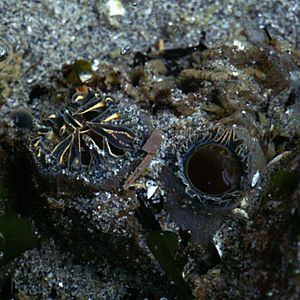Tresus capax facts for kids
Quick facts for kids Tresus capax |
|
|---|---|
 |
|
| Siphons of Tresus capax (Gould, 1850) | |
| Scientific classification |
Tresus capax is a type of saltwater clam. It's a marine bivalve mollusk, often called the fat gaper. It belongs to the Mactridae family. This clam also shares the name horse clam with Tresus nuttallii. Both types of horse clams look and live in similar ways. They are a bit like the geoduck (Panopea generosa), but smaller. Their shells can grow up to eight inches (20 cm) long. These clams can weigh between 3 and 4 pounds (1.4 to 1.8 kg).
The two main types of horse clams live along the Pacific coast in areas where the tide goes in and out. T. nuttallii, the pacific gaper, is more common in the south, towards California. T. capax, the fat gaper, is found more often in the north, up to Alaska. Both have shells that are oval-shaped and chalky white or yellow. They also have brown, leather-like patches on their shells. These clams are called "gapers" because their shells don't close all the way. This is because their siphon, a tube they use for breathing and eating, is too big to pull completely inside.
Contents
How to Tell Them Apart
It's easy to tell the two horse clam species apart. T. nuttallii usually has longer, narrower shells. This means its shell is longer compared to how tall it is. It also has bigger siphonal plates. These are hard, horny plates at the end of the siphon. Sometimes, you can even see tiny algae or barnacles growing on them. Because of these differences, T. capax is known as the "fat gaper." Its shell is wider and rounder.
Where Do They Live?
Horse clams live in the lower parts of the intertidal zone. This is the area of the beach that is sometimes covered by water and sometimes not. They can also be found in deeper waters, up to 50–60 feet (13–15 meters) deep. They like to bury themselves in sand, mud, and gravel. They usually dig down about 12–16 inches (30–41 cm). This makes them much easier to dig up than geoducks. Other clams, like butter and littleneck clams, also like these types of ground. So, horse clams are often found when people are digging for other clams.
Tiny Crab Roommates!
Horse clams often share their home with small commensal pea crabs. These crabs, called Pinnixa faba, are usually a mating pair. They enter through the clam's large siphon. They then live inside the clam's mantle cavity, which is the space where the clam's soft body parts are. You can easily see these crabs. They don't harm the clam or affect its meat if you plan to eat it. The clam meat is good and makes excellent chowder. In Washington, people who dig for clams often ignore horse clams. But in Oregon, they are more popular.
How Do They Reproduce?
Horse clams reproduce by releasing their eggs and sperm into the water. This is called broadcast spawning. Geoducks also reproduce this way. T. nuttallii clams usually spawn, or release their eggs, in the summer. T. capax clams, on the other hand, spawn in the winter.
Harvesting for Food
Long ago, Native Americans living on the Pacific coast valued horse clams. They were big, easy to find, and simple to catch. Today, geoducks are more popular and have become a special food.
It's important to know which type of clam you have. Different recipes work best for different species. To help keep clam populations healthy, the Washington State Department of Fish and Wildlife [1] sets rules. These rules include how many clams you can take and how big they must be. The Department of Health sometimes closes beaches. They do this for public health and safety reasons. You can find current information on their Marine Biotoxin website [2].
King County has a helpful guide to identify clams [3].
Some people who dig for clams don't think horse clams taste as good as other types. So, during clamming season, you might see horse clams left on the beach. Their shells are more fragile than they look. It's very important not to damage them if you don't plan to keep them. If they are damaged and left behind, the clams will soon die. Adult horse clams cannot rebury themselves. They need the pressure of the sand around them to stay safe and move. They can't hold their two big shell halves together to protect their soft bodies. Responsible clam diggers carefully rebury any horse clams they don't keep. They bury them to about the same depth where they were found.
Images for kids


